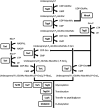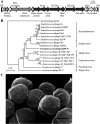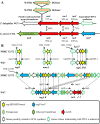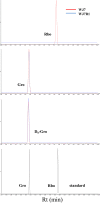Ribitol-Containing Wall Teichoic Acid of Tetragenococcus halophilus Is Targeted by Bacteriophage phiWJ7 as a Binding Receptor
- PMID: 35311554
- PMCID: PMC9045211
- DOI: 10.1128/spectrum.00336-22
Ribitol-Containing Wall Teichoic Acid of Tetragenococcus halophilus Is Targeted by Bacteriophage phiWJ7 as a Binding Receptor
Abstract
Tetragenococcus halophilus, a halophilic lactic acid bacterium, is used in the fermentation process of soy sauce manufacturing. For many years, bacteriophage infections of T. halophilus have been a major industrial problem that causes fermentation failure. However, studies focusing on the mechanisms of tetragenococcal host-phage interactions are not sufficient. In this study, we generated two phage-insensitive derivatives from the parental strain T. halophilus WJ7, which is susceptible to the virulent phage phiWJ7. Whole-genome sequencing of the derivatives revealed that insertion sequences were transposed into a gene encoding poly(ribitol phosphate) polymerase (TarL) in both derivatives. TarL is responsible for the biosynthesis of ribitol-containing wall teichoic acid, and WJ7 was confirmed to contain ribitol in extracted wall teichoic acid, but the derivative was not. Cell walls of WJ7 irreversibly adsorbed phiWJ7, but those of the phage-insensitive derivatives did not. Additionally, 25 phiWJ7-insensitive derivatives were obtained, and they showed mutations not only in tarL but also in tarI and tarJ, which are responsible for the synthesis of CDP-ribitol. These results indicate that phiWJ7 targets the ribitol-containing wall teichoic acid of host cells as a binding receptor. IMPORTANCE Information about the mechanisms of host-phage interactions is required for the development of efficient strategies against bacteriophage infections. Here, we identified the ribitol-containing wall teichoic acid as a host receptor indispensable for bacteriophage infection. The complete genome sequence of tetragenococcal phage phiWJ7 belonging to the family Rountreeviridae is also provided here. This study could become the foundation for a better understanding of host-phage interactions of tetragenococci.
Keywords: Tetragenococcus halophilus; bacteriophage; host receptor; wall teichoic acid.
Conflict of interest statement
The authors declare no conflict of interest.
Figures






Similar articles
-
Identification of Capsular Polysaccharide Synthesis Loci Determining Bacteriophage Susceptibility in Tetragenococcus halophilus.Microbiol Spectr. 2023 Jun 15;11(3):e0038523. doi: 10.1128/spectrum.00385-23. Epub 2023 May 8. Microbiol Spectr. 2023. PMID: 37154759 Free PMC article.
-
Crystallographic analysis of TarI and TarJ, a cytidylyltransferase and reductase pair for CDP-ribitol synthesis in Staphylococcus aureus wall teichoic acid biogenesis.J Struct Biol. 2021 Jun;213(2):107733. doi: 10.1016/j.jsb.2021.107733. Epub 2021 Apr 2. J Struct Biol. 2021. PMID: 33819634
-
Transposition of IS4 Family Insertion Sequences ISTeha3, ISTeha4, and ISTeha5 into the arc Operon Disrupts Arginine Deiminase System in Tetragenococcus halophilus.Appl Environ Microbiol. 2019 May 2;85(10):e00208-19. doi: 10.1128/AEM.00208-19. Print 2019 May 15. Appl Environ Microbiol. 2019. PMID: 30877114 Free PMC article.
-
Interactions of the cell-wall glycopolymers of lactic acid bacteria with their bacteriophages.Front Microbiol. 2014 May 22;5:236. doi: 10.3389/fmicb.2014.00236. eCollection 2014. Front Microbiol. 2014. PMID: 24904550 Free PMC article. Review.
-
Formation of biofilm changed the responses of Tetragenococcus halophilus to ethanol stress revealed by transcriptomic and proteomic analyses.Food Res Int. 2022 Nov;161:111817. doi: 10.1016/j.foodres.2022.111817. Epub 2022 Aug 24. Food Res Int. 2022. PMID: 36192889 Review.
Cited by
-
Polysaccharide intercellular adhesin and proper phospholipid composition are important for aggregation in Tetragenococcus halophilus SL10.Appl Environ Microbiol. 2024 May 21;90(5):e0033424. doi: 10.1128/aem.00334-24. Epub 2024 Apr 16. Appl Environ Microbiol. 2024. PMID: 38624197 Free PMC article.
-
Identification of Capsular Polysaccharide Synthesis Loci Determining Bacteriophage Susceptibility in Tetragenococcus halophilus.Microbiol Spectr. 2023 Jun 15;11(3):e0038523. doi: 10.1128/spectrum.00385-23. Epub 2023 May 8. Microbiol Spectr. 2023. PMID: 37154759 Free PMC article.
-
Targeted Screening for Spontaneous Insertion Mutations in a Lactic Acid Bacterium, Tetragenococcus halophilus.Appl Environ Microbiol. 2023 Mar 29;89(3):e0200522. doi: 10.1128/aem.02005-22. Epub 2023 Feb 21. Appl Environ Microbiol. 2023. PMID: 36809065 Free PMC article.
-
Uncovering differences in the composition and function of phage communities and phage-bacterium interactions in raw soy sauce.Front Microbiol. 2023 Dec 22;14:1328158. doi: 10.3389/fmicb.2023.1328158. eCollection 2023. Front Microbiol. 2023. PMID: 38188564 Free PMC article.
-
Identification of an operon and its regulator required for autoaggregation in Tetragenococcus halophilus.Appl Environ Microbiol. 2023 Dec 21;89(12):e0145823. doi: 10.1128/aem.01458-23. Epub 2023 Nov 28. Appl Environ Microbiol. 2023. PMID: 38014957 Free PMC article.
References
-
- Kuda T, Izawa Y, Ishii S, Takahashi H, Torido Y, Kimura B. 2012. Suppressive effect of Tetragenococcus halophilus, isolated from fish-nukazuke, on histamine accumulation in salted and fermented fish. Food Chem 130:569–574. doi:10.1016/j.foodchem.2011.07.074. - DOI
-
- Uchida K, Kanbe C. 1993. Occurrence of bacteriophages lytic for Pediococcus halophilus, a halophilic lactic-acid bacterium, in soy sauce fermentation. J Gen Appl Microbiol 39:429–437. doi:10.2323/jgam.39.429. - DOI
Publication types
MeSH terms
Substances
Supplementary concepts
LinkOut - more resources
Full Text Sources
Molecular Biology Databases

